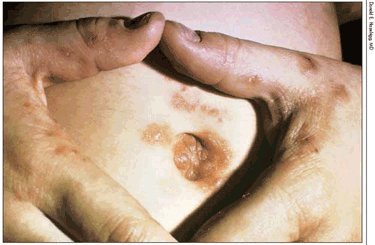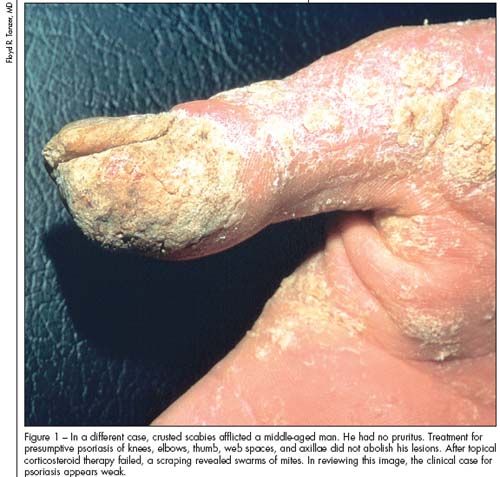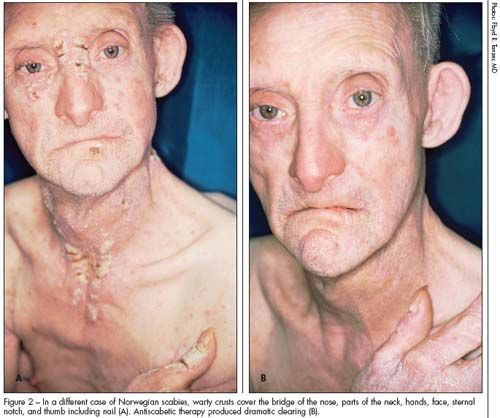Child With Itchy Hands and Navel
Scabies is often seen in axillary folds and the periumbilical area; severe nocturnal itching is a hallmark.
This article was originally presented as an independent educational activity under the direction of CME LLC. The ability to receive CME credits has expired. The article is now presented here for your reference. CME LLC is no longer responsible for the presentation of the article.

HISTORY
An 8-year-old child with intense itching, worst about the thumbs, adjacent dorsum of the hand, and navel. No prior medical problems. Not exposed to poison ivy recently. Other family members have not had the same symptom. Not clear if the pruritus is worse at night.
PHYSICAL EXAMINATION
Generally healthy. Developmentally appropriate for age. Normal vital signs. Abnormal findings confined to the skin and consist of linear and round areas of reddish brown discoloration, sometimes confluent. Lesions are most prominent in and about the navel.
WHAT'S YOUR DIAGNOSIS?
WHAT'S YOUR DIAGNOSIS?
ANSWER: SCABIES
The history of severe itching, especially in the web spaces of the hands, raises the spectre of scabies. The areas around the thumbs are littered with red-brown erosions and papules, individually nondiagnostic but aggregately suggesting scabies; the periumbilical involvement further raises the likelihood. Two linear scabbed areas, one at the base of the left thumb (near the reader's 3 o'clock position) and the other due distal to it, just at the first knuckle, could be burrows, though they could also just be linear excoriations. Examination of material scraped from one of the burrows yielded a recognizable Sarcoptes scabiei mite, confirming scabies.1-4 Although one can make the diagnosis from history, lesion distribution, and sometimes lesion morphology, many persons are treated-often overtreated-for presumptive scabies. The child was treated and, as is usual in scabies, cure was effected.5
SYMPTOMS AND CONTEXT
Pruritus is a hallmark of scabies, but the oft-mentioned nocturnal itching is not so specific as one might hope. The itch is severe and generalizes far beyond the locale of the individual infesting mites, to involve the whole body below the chin.
Both underdiagnosis and overdiagnosis of scabies occur commonly; one instance of misinferring “scabies bites [sic]” in bullous pemphigoid is recalled in the title of a prior “What's Your Diagnosis?” column.6 Diverse dermatoses mimic the condition, and other problems can mask it. One prominent mask is reduced immune reaction: ordinarily it is the host's inflammatory reaction to the female mite-and it is only the females that burrow into the skin-that produces the itching and irritation which suggest the diagnosis. When for any reason, including advanced HIV infection, this reaction is suppressed or scant, scabies incognito (hidden scabies) can result.
PHYSICAL FINDINGS IN SCABIES
In an adult, the highest-yield places to look for scabies lesions are web spaces between the fingers; nipples and areolae; penis and scrotum; lower buttocks; and elbows and wrists. Most patients have only papules, vesicles- but not the clustered vesicles of herpesvirus infections- excoriations, and pustules. In the minority of instances in which mite burrows are found, they are thin linear “welts” easily mistaken for excoriations, though as the British characterize them they are “short, wavy, scaly, grey line[s] on the skin surface.”2 A vesicle at the end of the burrow may contain the female mite; discerning a live mite without a magnifying device is unlikely. Some dermatologists employ the ×10 magnification of dermatoscopes to enhance recognition of the complex of triangular blind head, biting apparatus, and front legs-which should point further in at the deepest recess of the burrow unless the mite is in transit.4
Axillary folds can be attacked, as can the periumbilical area, which is prominently affected in our index patient. Sides of the hands and flexor surfaces of the wrists are also commonly involved.
Everything written about scabies has qualifiers and exceptions: Mites favor skin below the neck except in infants; but scalp lesions have been found in adults, and have provided sanctuary and reservoir from which recurrences have arisen when treatment was given to all skin below the chin, as recommended in non-pediatric cases.1,5 Lightly keratinized skin, bearing few hairs and oil glands, is said to be attractive to the mites; sparing of palms and soles in non-infants is then explained by the thickness of the keratin layer there; but the keratin layer is considerable even in infants, yet mites notoriously burrow there; and the involvement of the fingernails in crusted scabies would also seem completely contradictory to this assertion.
SECONDARY INJURY HIDES THE CULPRIT
Intense scratching typically converts areas of infestation into a sea of papules, erosions, and patches. With bacterial superinfection, impetiginized areas can even bear honey-colored crusts. Prominent excoriation often obscures the underlying condition. Our patient does not show frank impetiginization, nor recognizable burrows; in this respect he is typical: the history makes a good case for the condition, and the individual lesional morphology is nonspecific, but the aggregate picture emerges with enough to allow a confident diagnosis.
If the interpretation in any suspect case is unclear, one can seek to identify mites, their eggs, or their feces on a skin scraping from a burrow or papule. The technique as specified by Karthikeyan is the same used by a veterinarian seeking evidence of sarcoptic mange, an illness caused by the subspecies or variant canis (and not a source for human scabies, by the way): “a drop of mineral oil is placed on a sterile scalpel blade and 5 to 6 suspicious lesions are scraped”5 “laterally across the skin with a blade, taking care to avoid bleeding.”1 Karthikeyan wraps up, “The scrapings and oil are placed on a glass slide and covered with a cover slip for examination. The presence of any stage of the mite is diagnostic. Though this procedure is simple, a skilled technician or dermatologist is required to obtain good results.”5 Even at that, false-negatives abound, so a positive result will secure the diagnosis but a negative one does not exclude it.
CRUSTED SCABIES
This horrid variant occurs when the host inflammatory response is sharply attenuated, or perhaps rarely just from chaotic filthy living conditions.7,8 Instead of the usual 5 to 15 mites in ordinary scabies, thousands to millions can swarm,1,9 and become crusted (“Norwegian”) scabies. The crusted variant does not itch, and so the principal host reaction is not inflammation but just hyperkeratosis (Figures 1 and 2),1,2,7,8 which can render the skin psoriatic-looking though the mimicry is more apparent than real: no background erythema in Norwegian scabies, and no silvery scale.

Crusted scabies is not only deeply distressing to both the patient and all caregivers, but also far more contagious to other residents and to staff. The single helpful feature in Norwegian scabies, and it provides at best cold comfort, is the ease of finding mites in scrapings.

Unfortunately, telephone orders for empiric topical corticosteroid therapy can create a perfect setting for exacerbation of any case of scabies: a nurse calls about a patient who has a reportedly nondescript rash, typically someone who resides in a nursing home. A sincere request for something to alleviate the old person's misery is made on the telephone, without full weight given by either party to the pruritic element. Then what seems the quickest, most merciful response, to order a topical corticosteroid, backfires: If the clinician orders a corticosteroid, sight unseen, and the sequence plays out, the symptom will indeed ease and clear, but the mites will breed and they will out.
PANIC, STIGMA, TREATMENT
Terror and disgust are universal clinician reactions to the mere word scabies, utterly disproportionate to its sparse danger. Apart from secondary bacterial infection, and a path to post-streptococcal glomerulonephritis,1 damage to internal organs is not expected. Rather, revulsion reflects psychological distress about a “dirty” disease.
Permethrin 5% cream is highly effective and less likely to cause both local dermal toxicity and systemic problems than the old standard, lindane (“Kwell”). Since everybody craves a plan of action, and usually wants it instantaneously when the dreaded S-word has been spoken, the reader is referred to the CDC's fine Web site with answers for both laypersons and health care workers.10 Although I prefer chemical to brand names of drugs, one brand of permethrin aids memory nicely: ElimiteTM, which eliminates the mite and thus helps match drug and indication. Oral 1-dose ivermectin is also effective as an alternative, and some highly reputed authorities would repeat the dose 14 days later.1
AN APPROACH IN THE NURSING HOME
A sample set of orders for a single established case in a nursing home could read:
At bedtime on the evening when the diagnosis is made:
•Strip bed of linen including pillow cases and sheets.
•Collect all recently worn and unlaundered clothing, including whatever the patient is currently wearing-both outer and undergarments.
•Wash all linen and clothing in hot water cycle of washing machine and dry on high heat cycle.
•Spray items that can't go in the machine (bed, pillows, mattress) with cyfluthrin (a pyrethrin relative) spray, to kill any mites struggling to survive outside the body.1-3,7,9
•Have patient take a shower at whatever temperature is comfortable, and dry the skin gently but thoroughly afterward (pat dry rather than rub).
•Apply permethrin 5% cream to cover every bit of the patient's body from chin to toes, including perineum, all finger and toe webs, gluteal fold skin (but not anal canal or any other mucosa), buttocks, navel, wrists, axillae, and under nails as far as can be comfortably applied. Massage in the permethrin.
•Leave on for 8 hours as patient sleeps overnight.
•Wash off thoroughly in a shower or bath 8 hours after application.
The older recommendation to repeat these steps 48 hours after initial treatment appears to be overkill, and the excellent information for the public on the CDC Web site10 might not go even this far.
One need not be frightened by days or even weeks of post-treatment pruritus. Such itching reflects hypersensitivity to mite antigens that have not yet been cleared from the body after death of the mites: the body needs time to clear the debris.
Brilliant formulations of the differential diagnosis of post-treatment pruritus list among other prospects improper or inadequate treatment, contact dermatitis from overtreatment, true resistance which is rare, and delusions of parasitosis.11
Schneiderman H. Scabies: beyond the reaction of horror. CONSULTANT. 2009;49:752-757.
References:
REFERENCES:
1. Chosidow O. Clinical practices. Scabies.
N Engl J Med
. 2006;354:1718-1727.
2. Johnston G, Sladden M. Scabies: diagnosis and treatment.
BMJ
. 2005;331(7517):619-622.
3. Meyers WM, Connor DH. Scabies. In: Bindford CH, Connor DH, eds.
Pathology of Tropical and Extraordinary Diseases
. Washington, DC: Armed ForcesInstitute of Pathology; 1976:615-617.
4. Prins C, Stucki L, French L, et al. Dermoscopy for the in vivo detection of
Sarcoptes scabiei
. Dermatology. 2004;208:241-243.
5. Karthikeyan K. Treatment of scabies: newer perspectives.
Postgrad Med J
.2005;81(951):7-11.
6. Schneiderman H, Dana MF. A serpiginous blood blister and “scabies bites”:a confusing presentation of bullous pemphigoid.
Consultant
. 2004;44:449-457.
7. Bongiorno MR, Ferro G, Arico M. Norwegian (crusted) scabies of glanspenis in an immunocompetent patient.
Br J Dermatol
. 2009;161:195-197.
8. Chan CC, Lin SJ, Chan YC, Liao YH. Clinical images: infestation by Norwegianscabies.
CMAJ
. 2009;181:289.
9. Buehlmann M, Beltraminelli H, Strub C, et al. Scabies outbreak in an intensivecare unit with 1,659 exposed individuals-key factors for controlling the outbreak.
Infect Control Hosp Epidemiol
. 2009;30:354-360.
10. Scabies. Centers for Disease Control and Prevention Web site.
http://www.cdc.gov/scabies
. Accessed November 15, 2009.
11. Anonymous. The matchbox sign.
Lancet
. Jul 30 1983:261.
2 Commerce Drive
Cranbury, NJ 08512
All rights reserved.